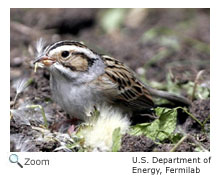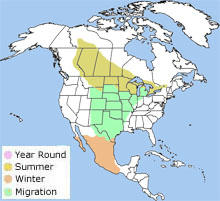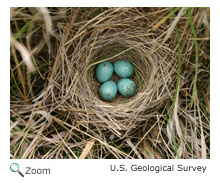Description
 The clay-colored sparrow is 4.5 inches in length. It has a pale, conical bill with a black tip. It has a brown crown with darker brown streaks and a tan back and brown streaked wings with two white wing-bars. It has a gray band that runs across the nape of its neck, and it has a light grayish-brown chest and belly. It has a brown rump and a thin, slightly forked tail. During breeding season, it has a white throat patch, brown cheeks bordered by black, and white eyestripes. Males and females look alike.
Its call is a raspy "bzzz-bzzz-bzzz". The clay-colored sparrow is 4.5 inches in length. It has a pale, conical bill with a black tip. It has a brown crown with darker brown streaks and a tan back and brown streaked wings with two white wing-bars. It has a gray band that runs across the nape of its neck, and it has a light grayish-brown chest and belly. It has a brown rump and a thin, slightly forked tail. During breeding season, it has a white throat patch, brown cheeks bordered by black, and white eyestripes. Males and females look alike.
Its call is a raspy "bzzz-bzzz-bzzz".
Range  The clay-colored sparrow breeds from north-central Canada and the Great Lakes region south to Montana and Michigan. It spends winters from southern Texas south. There is no overlap in the clay-colored sparrow's winter and summer ranges. The clay-colored sparrow does not breed in New Hampshire, but occasionally a vagrant finds its way into the state. The clay-colored sparrow breeds from north-central Canada and the Great Lakes region south to Montana and Michigan. It spends winters from southern Texas south. There is no overlap in the clay-colored sparrow's winter and summer ranges. The clay-colored sparrow does not breed in New Hampshire, but occasionally a vagrant finds its way into the state.
Habitat
The clay-colored sparrow is found in brushy grasslands and prairies.
| |
Diet The clay-colored sparrow eats seeds and some insects.
Life Cycle
 The male clay-colored sparrow reaches the breeding territory first. He sings to attract a mate and defend his territory. The female builds an open-cup nest of twigs, weeds, and grass. The nest is made close to the ground in a shrub. She lays 3-5 blue eggs and does most of the incubating. The male helps out a little and feeds the female during incubation. Incubation takes about 10-12 days. Both the male and the female feed the chicks. The chicks fledge when they are about 8-9 days old, but their parents will continue to feed and care for them for another week. The male clay-colored sparrow reaches the breeding territory first. He sings to attract a mate and defend his territory. The female builds an open-cup nest of twigs, weeds, and grass. The nest is made close to the ground in a shrub. She lays 3-5 blue eggs and does most of the incubating. The male helps out a little and feeds the female during incubation. Incubation takes about 10-12 days. Both the male and the female feed the chicks. The chicks fledge when they are about 8-9 days old, but their parents will continue to feed and care for them for another week.
BehaviorWhen prairies were turned into farmland, the clay-colored sparrow lost some habitat, but forest clearing has opened up new areas to this small songbird.
|


 The clay-colored sparrow breeds from north-central Canada and the Great Lakes region south to Montana and Michigan. It spends winters from southern Texas south. There is no overlap in the clay-colored sparrow's winter and summer ranges. The clay-colored sparrow does not breed in New Hampshire, but occasionally a vagrant finds its way into the state.
The clay-colored sparrow breeds from north-central Canada and the Great Lakes region south to Montana and Michigan. It spends winters from southern Texas south. There is no overlap in the clay-colored sparrow's winter and summer ranges. The clay-colored sparrow does not breed in New Hampshire, but occasionally a vagrant finds its way into the state.